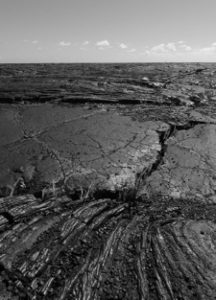Cinders as Far as the Eye Can See
October 1, 2018Podcast: Download (Duration: 3:33 — 4.9MB)
Subscribe: More
 While I explored central Idaho’s Snake River Plain, I camped at Craters of the Moon National Monument. I had a weather satellite photo, on which the Snake River Plain forms a curving band of tan and green, fading to gray where the volcanic track of the Yellowstone Hotspot comes in. Against those muted colors, the black lava fields in Craters of the Moon stick down from the north like a sore thumb.
While I explored central Idaho’s Snake River Plain, I camped at Craters of the Moon National Monument. I had a weather satellite photo, on which the Snake River Plain forms a curving band of tan and green, fading to gray where the volcanic track of the Yellowstone Hotspot comes in. Against those muted colors, the black lava fields in Craters of the Moon stick down from the north like a sore thumb.
The eruptions that formed these fields began through a 75-mile crack in the earth’s crust, back in the days of the Columbian mammoth. Lava spewed for thousands of years, finally ceasing while the first Caesars ruled Rome. The cinders have long cooled. Now they stretch as far as the eye can see,
a thousand square miles of blasted desert.
I stood one morning on the highway pullout above Craters of the Moon, gazing at the black horizon of this volcanic sideshow. My eye strayed back from the horizon and lit on a nearby tuft of vegetation growing from a crack between volcanic boulders. At first it seemed incongruous that a wildflower could struggle up from such barrenness. A couple thousand years of dust must have settled into the bottom of that crack to support it. And a seed blew in. A sprinkle of rain now and then, and seeds have no choice but to try to grow wherever they land.
Lava fields are incredibly rugged terrain. Traveling off designated walkways is prohibited, but even if a person tried, basalt edges sharp as broken glass would quickly cut even the stoutest shoes to ribbons. Yet everywhere I wandered, grasses and wildflowers sprouted from fissures and low places. It might take thousands more years, but they are going to show the harsh stone who’s boss. There, it seems to me, is a lesson in persistence.
It struck me like a flash: T. S. Eliot was wrong, April is not the cruelest month, breeding flowers from the
dead land. Flowers breeding from the dead land is an act of heroism which merits deep human reverence. Ever and always, amid Extinction Events or these lava fields or whatever the backside of human technology may do to us, life will ever venture forth upon the blasted land.
If we want the meaning of life, as far as I’m concerned, there it is. Human greatness, I say, is a delusion. Achievement is just a spark against the relentless winds and limitless tides of time and change. But a seed drills into new soil, a hand is offered to a new stranger. As long as our species endures, that will be the meaning and achievement that matters.
Excerpted from Dennis McCarty’s book Reflections: On Time, Culture, and Spirits in America.
Dennis is Minister Emeritus at the Unitarian Universalist Congregation of Columbus, Indiana. He has two accomplished adult daughters, Erin, and Colleen, and two grandchildren, Moira and Quinn. He lives in Bloomington, Indiana, with his life partner, Kate, and two pampered cats. His latest book, Reflections: On Time, Culture, and Spirits in America, was published in April.
- Cinders as Far as the Eye Can See - October 1, 2018
Quest Monthly Print Edition
Recent Issues
Latest Spiritual Reflection Posts
Weekly Newsletter
About
Quest for Meaning is a program of the Church of the Larger Fellowship (CLF).
As a Unitarian Universalist congregation with no geographical boundary, the CLF creates global spiritual community, rooted in profound love, which cultivates wonder, imagination, and the courage to act.
Contact
Church of the Larger Fellowship Unitarian Universalist (CLFUU)
24 Farnsworth Street
Boston MA 02210

